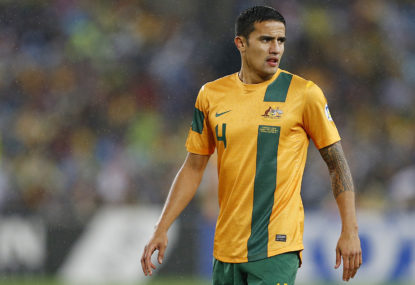Of all the things Ange Postecoglou discussed in the wash-up to Australia’s encouraging performances in Brazil, the thing that stood out was his desire to add more dimensions to the Socceroos attack.
Paraphrased, he suggested that, due to the limited time he had with the squad ahead of the World Cup, he decided to be a little one-dimensional in attack, utilising the obvious strength that is Tim Cahill’s aerial ability.
What he suggested in the post tournament analysis is that the Roos would need to add a few more dimensions to the attack as they build towards a home Asian Cup in January.
What we should see, starting with highly ranked Belgium in Liege tomorrow morning, is that the Socceroos are at least starting to think and plan for the inevitability that Cahill won’t be around forever.
While he still, to this day, remains a world-class threat in the air, Australia’s one-touch-finish merchant is unlikely to be around much longer after the Asian Cup.
Indeed, a home tournament may well be the perfect way for our all-time leading scorer to sign-off from the green and gold.
Either way Postecoglou has to start building a front third formula that not only plays to Australia’s traditional aerial strength, a plan that worked for Holger Osieck at the 2011 Asian Cup, but one that mixes it with a more eye-pleasing pass-and-move process.
The ideal in January would be to not only be effective in the air when Cahill is on the pitch, but to have a mobile and creative from third which can unlock defences through rapid circulation of ball and body.
It should be an attack that can create by going rapidly on the ground, or have the quality to break deep-sitting teams down.
These aren’t strategies that best utilise Cahill, and herein lies a dilemma for the manager.
We saw in Brazil the Socceroos lacked the intricate quality to break opponents down. Not having Tom Rogic, of course, didn’t help.
For all the impressive displays against Chile and The Netherlands, the Roos were still too reliant on the raw running power of Mat Leckie and Cahill’s leap and physicality.
From a creativity perspective, there were odd moments from Mark Bresciano, but ultimately there wasn’t enough front third combination play.
This is the bit that Postocoglou will be keen to address, and the games against Belgium tomorrow and Saudi Arabia in London next week should give us an insight into how he might do this.
Beyond that, there are friendlies against the United Arab Emirates and Qatar in the Middle East next month, and two home matches in November to round out Asian Cup preparations.
That’s only six games for Postecoglou to find his solutions and contingencies.
The manager hinted in the build up to his Belgium and Saudi selection that he’d be taking a few gambles as he continues to evolve the team from the mess that Osieck left behind.
Clearly Brazil was just a part of the process.
So far his gambling appears to have limited mainly to the back, an area that arguably needs more urgent attention than the front third.
To that end the likes of Trent Sainsbury, Chris Herd and Brad Smith should get their opportunities the next few days. The adaptable Josh Brillante, who can also play at right back, might be another benefactor.
Up front there is more of a status quo to the personnel. Only Robbie Kruse, who missed Brazil due to an anterior cruciate ligament injury, and Western Sydney Wanderers’ Tomi Juric come into this mix.
Just how many minutes either or both get remains to be seen. Kruse is recovering from a knee injury sustained at training 24 hours ago.
Even if he doesn’t get too many minutes against Belgium, Kruse’s return gives Postecoglou another quick option in transition.
Not only can Kruse go quickly with and without the ball, but he likes to play in quick combinations, giving it to go in behind and receive.
What Kruse’s return also does is give the manager the option of switching Leckie to the nine role, or wide on the left.
That also gives him the option of using Tommy Oar, who disappointed wide on the left in Brazil, as a number 10. This could well be on the cards in Liege.
Juric has been touted by much of Australia as the next Mark Viduka. He is anything but.
Viduka was the perfect creative link-man, a play-making number nine who made his teammates look good.
Juric’s linkage remains raw. He is more of a one-touch finisher, and a very good one at that.
It is conceivable that Juric will be the perfect hit-man from the bench, just as he was for the A-League All-Stars recently.
Yet even that adds another dimension to the Socceroos attack, and this is exactly what Postecoglou was talking about.
Between playing Leckie, Cahill and Juric in the number nine role there is much variety in the way the Roos can play.
Not even factoring in others who might come into the front-third mix, this gives Postecoglou and Ante Milicic tactical flexibility, and watching this area evolve in the lead up to the Asian Cup will make for fascinating viewing.





























































































